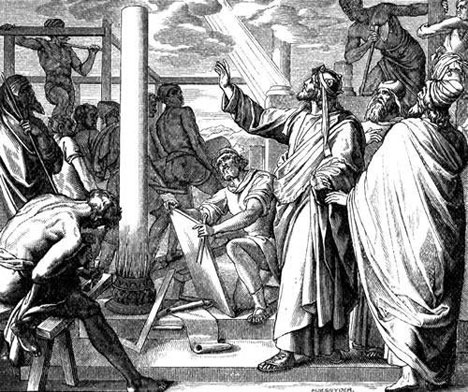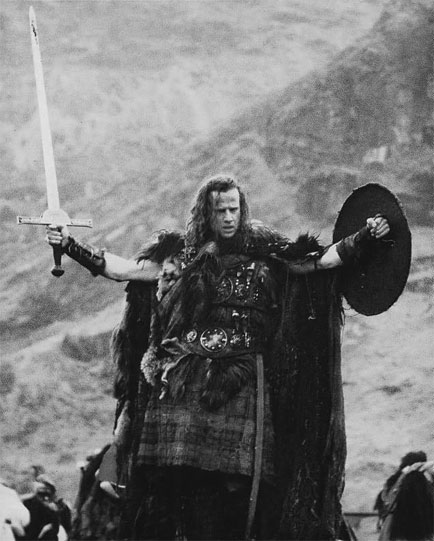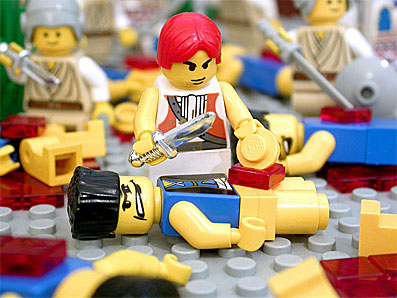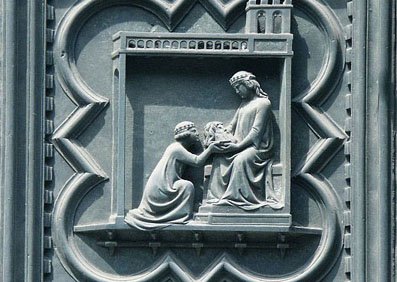Mar
24
2011

“And thou shalt set bounds unto the people round about, saying,
Take heed to yourselves, that ye go not up into the mount,
or touch the border of it:
whosoever toucheth the mount shall be surely put to death.”
Exodus 19:12
The Bible beats blood and water into us over and over again. Blood is death. Water is resurrection. Blood is the Bridegroom and water is the Bride.
Continue reading
5 comments | tags: Ascension, David, goliath, Laver, Moses, Revelation, Sinai, Tabernacle | posted in Bible Matrix, Biblical Theology, Creation, Totus Christus
Oct
18
2010

“Egypt, Judah, Edom, the people of Ammon, Moab, and all who are in the farthest corners, who dwell in the wilderness. For all these nations are uncircumcised, and all the house of Israel are uncircumcised in the heart.” - Jeremiah 9:26
Reading through the Old Testament as a young Christian, I always felt the Bible got bogged down when the Lord started pronouncing judgments upon nations other than Israel. For starters, I hadn’t paid enough attention earlier to remember who these sovereign states were. And more to the point, wasn’t God losing the plot a bit? I mean, there were plenty of other peoples during these times which aren’t even mentioned in the Bible at all.
Unfortunately, few commentators take the Bible seriously enough to understand what is actually going on. Older books will fill you in on the background, which is certainly helpful. But the big question is Why is God doing this now?, both now in history and now in the prophet I am reading?
As usual, when the structure and context of things is understood, seemingly boring “classic” texts suddenly come to life. In the case of the prophets it is a consuming fire. Continue reading
Comments Off | tags: Babylon, Creation Week, David, Egypt, Ezekiel, goliath, Literary Structure, Numbers, Numbers 5, Revelation, Solomon | posted in Bible Matrix, Biblical Theology, The Last Days, The Restoration Era
Sep
2
2010

From James B. Jordan’s fascinating Thoughts on Jachin and Boaz [1]
“The Tabernacle and Temple were not only pictures of the kingdom of God. They were also pictures of the human person (John 2:21). We have noted that the High Priest had a chain around his neck, and pomegranates and bells encircling the ephod. Without any difficulty we can see the 1-cubit collar of the pillar as a neckband, the lily as the head, and the bronze shaft as the trunk. The size and proportions are roughly equivalent to those of a 5’ man.
Continue reading
Comments Off | tags: goliath, James Jordan, Temple | posted in Biblical Theology
Feb
11
2010
 God took on a body, from the dust, in Adam. A trillion particles of inanimate, dead stuff pulled together and organised into the most complex system in the cosmos, an organic machine capable of feats we are yet to discover.
God took on a body, from the dust, in Adam. A trillion particles of inanimate, dead stuff pulled together and organised into the most complex system in the cosmos, an organic machine capable of feats we are yet to discover.
Adam, as Covenant head, also took on a “body.” A Divine Handful of flesh and bone, dead or dying by any human measure, organised into a being more palatial and lavish than any male eye is worthy to behold.
Continue reading
3 comments | tags: Abraham, David, Film, goliath, Herod, Nimrod, Satan, The flood, Totus Christus, Totus Diabolus | posted in Biblical Theology, The Last Days, Totus Christus
Jul
28
2009

How smart is this Book?
As discussed, if we begin with Saul’s anointing by Samuel, subsequent events follow the Feasts outline. Saul’s failure to kill Amalek is at Pentecost and his failure to defeat Goliath is at Atonement.
BUT… if we begin with David’s secret anointing by Samuel, subsequent events also follow the Feasts. This time, however, David’s slaying of Goliath is at Pentecost (the serpent/beast in the wilderness). Guess what’s at Atonement?
Continue reading
1 comment | tags: Amalek, Bible Matrix, Circumcision, David, Eglon, Ezekiel, Feasts, goliath, High Priest, Saul, Sidon, Systematic typology, Tabernacles, Tyre | posted in Biblical Theology
Jul
26
2009

“In the sweat of your face you shall eat bread till you return to the ground…” (Genesis 3:19)
The book of Judges continually uses the imagery of the crushing of the heads of the Lord’s enemies, whether this is literal skulls or heads of state. The Bible makes a big deal of heads and bodies, whether this is the sacrifices picturing the totus Christus, or His rival, Gog and Magog.
Continue reading
Comments Off | tags: Atonement, David, Gethsemane, goliath, High Priest, Moses, Typology, Uzziah | posted in Biblical Theology
Apr
15
2009
Ordinary People
In Judges and 1 Samuel, the weapons used to defeat the enemy reflect the ordinary people who used them: a tent peg, an ox goad, a millstone, an ass’s jawbone, a slingshot. It was Saul who started throwing spears like a Gentile, like Goliath.
Our weapons are not of this world, but many of them are still physical weapons: bread, wine, water, oil, bended knees, soundwaves, books, gifts, open ears, hospitality, open or closed church doors. These physical things capture people’s thoughts and make them obey Christ.
We live in this world, but we don’t act like its people or fight our battles with the weapons of this world. Instead, we use God’s power that can destroy fortresses. We destroy arguments and every bit of pride that keeps anyone from knowing God. We capture people’s thoughts and make them obey Christ. And when you completely obey him, we will punish anyone who refuses to obey.” 2 Cor 10:3-6 [CEV]
WEPOW
Comments Off | tags: goliath, Holy war, Judges, Saul | posted in Biblical Theology, Christian Life
Apr
10
2009

Peter Leithart observes that both Esther and Herodias’ daughter are promised up to “half the kingdom.”
There are echoes in the story of the book of Esther, at least in Mark’s version of John’s execution. Matthew tells us that when the daughter of Herodias danced before Herod, he promised with an oath to give whatever she asked. Mark records Herod’s words somewhat differently: He promises not just to give what she asks, but promises to give up to half his kingdom (Mark 6:22-23). This is the same promise that Ahasuerus gives to Esther when she says she has a request for him (5:3, 6).
In both passages, we have a woman, a queen, requesting something from a king. In both stories, we have a king promising half his kingdom. We could even say that both Esther and Herodias are asking for someone’s head. Esther knows that Haman is plotting to kill all the Jews, and she is asking for his life in order to protect the Jews.
But there the similarities end. Esther appeals to the king to save the faithful in Israel, while the daughter of Herodias is instructed instead to ask for the head of a faithful man, albeit a troubler of Herod’s kingdom, a prophet who has made life difficult for Herod because of his faithfulness. Instead of being like the protective Ahasuerus in Esther, Herod is more like Haman, seeking to wipe out the true Israel.
http://www.leithart.com/2008/06/21/herodias-and-esther/
Esther, like Deborah, and Jael, typifies Mary, the warrior bride whose offspring would crush the head of the serpent. A Nazirite growing his hair during a ‘holy war’ vow identified him with submission and purity. John uses Nazirite symbols to describe the bad Nazirites, the Judaising “locusts” troubling the church.
“And they had hair as the hair of women, and their teeth were as the teeth of lions.” Revelation 9:8 (and Joel 1:6)
They were negative-Nazirites, men who had taken vows to destroy the apostles (Acts 21:23). With the charm (and hair) of an army of Absaloms, their holy war was stamping out the Son of David. They were the false warrior bride, Herodias, seeking the head of the true Nazirite, Christ, in revenge for the victory over Goliath at the cross. This Herodias-Jezebel-Babylon of superseded Judaism would wipe out the true Israel at any cost.
Comments Off | tags: Babylon, Esther, goliath, Herodias, Jezebel, Nazirite, Peter Leithart | posted in Biblical Theology
































